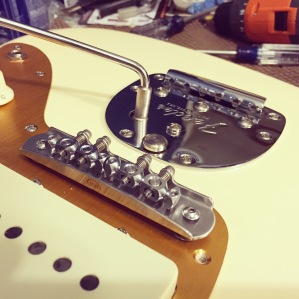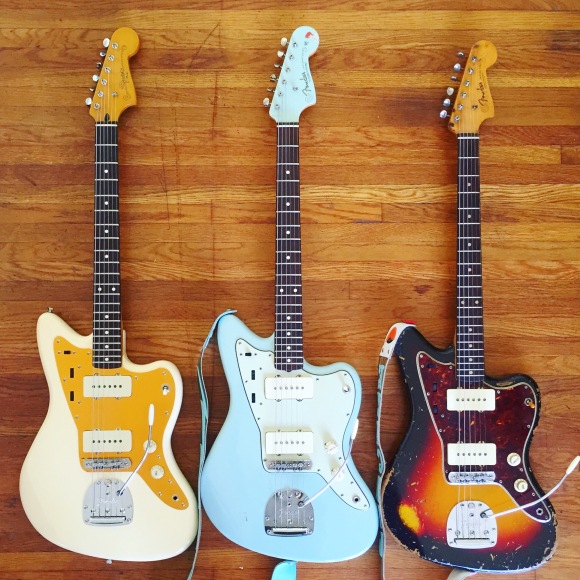
A bad guitar, 1961
In a recent interview with Reverb.com, Fender CEO Andy Mooney laid bare his true feelings about the Jazzmaster and Jaguar, and let me tell you, they were anything but glowing. In the exchange, he brands Leo Fender’s original designs as “not very good guitars” at the time of release, declaring the mistakes of the past fixed in Fender’s latest entries into the offset line.
Mooney takes a hard stance here, but to be honest his perspective here is nothing new. These critiques have been around for years, and even with the informed views of dedicated users of the Offset Guitar forum, the main axe associations with high profile players like Chris Stapleton and Nels Cline, and my own work over the last decade advocating for the guitars in print and performance –– pardon the horn tooting –– opinions on these fascinating guitars among the general populace are still very much divided.
I don’t blame folks for holding these opinions because even I, Dear Reader, once believed the very same things. Back in high school I had an Olympic white Japanese Jaguar, a parental purchase spurred on by my love of the band Bush. The kindest way I could describe the guitar is problematic; the strings skipped off of their saddles, the bridge shimmied down, and it would not stay in tune no matter what I did.
Eventually I traded it in on something more reliable, unwilling to wrestle with the instrument. When I finally came back to the offset guitar 14 years later, I realized that insatiable tinkerer Leo Fender wouldn’t have released a guitar he didn’t think was ready, and so I pushed through my preconceived notions of its flaws to gain a better understanding of the thing. I came out on the other side with a deeper appreciation for the man’s work.
It seems to me that when a player has a bad experience with these guitars, it’s often because they’ve been poorly maintained. In cases such as these, I view it as an opportunity to educate and reevaluate. After a conversation or a quick adjustment, the player might still decide the models aren’t for them, but more often than not they seem to “get it.” And that’s enough for me.
So here I am, returning from an extended hibernation like a grumpy, shaggy bear; like the aging ensemble cast of a ‘90s sitcom, lured into a reunion for the cameras by the dangling carrot of a handsome payday, each secretly knowing that the end product would not be nearly as good as the show’s initial run; like a cherished childhood movie that, upon re-viewing for the first time in 30 years, has way more adult themes than your young mind could then comprehend, causing feelings of retroactive discomfort because you watched it with your parents in the SAME ROOM???
Prodigal namesake that I am, I have returned with my proverbial pen pressed to the also proverbial page of the Guitar Bar website to feverishly scrawl this open[ish] response in an attempt to give some context and gentle rebuttal to his comments.
“They were not particularly good guitars when they were first introduced.”
When the Jazzmaster and Jaguar were first released in 1958 and 1962 respectively, they were not only top of the line models, but top sellers as well. While neither model was exactly embraced by the Jazz community, they nonetheless found favor with a varied group of players and all but defined the sound of Surf music while still in its infancy. For a time, they seemed to be everywhere. Admittedly, perceived popularity does not a good guitar make, so let’s look at a handful of early adopters.
At first, session players and country pickers liked the models well enough to use them on stage and in the studio, including Wayne Moss, Hank Garland, Willie Nelson, and Luther Perkins, who has an engraving of the model on his tombstone. If more proof is needed, here are three separate performances of Roy Clark absolutely shredding “12th Street Rag” on a bone stock Jazzmaster and Jaguar. These videos remain favorites of mine because they show someone really digging in and playing fast melodic runs on guitars that people seem to think can’t handle that kind of vigorous right hand technique.
But if they were so good to begin with, why did sales eventually taper off?

A refinished ’65 from a couple of years back. I actually put the stock bridge back on this one instead of the sloppily installed TOM. It was awesome.
Previously, I’ve explained that the most common complaints with the model aren’t the fault of the design, but rather, trying to make that design do things it was never intended to do: wearing a set of light gauge strings.
In the Jazzmaster, Leo Fender’s intention was to appeal to Jazz guitarists by creating a solid body guitar with the string geometry of an archtop: a pitched-back neck, a floating bridge, and a tailpiece, and most importantly, all specifically designed to work with heavy gauge flat wound strings. We’re talking 12s, 13s, and 14s.
Once lighter gauges (9s and 10s) became the norm in the early to mid 1960s, inadequate string tension reduced the downward force on the bridge, resulting in tuning problems and string skipping. It’s like going off-roading with bald tires: you can certainly do it, but expect to slide around a bit.
At this point in my career I’ve set up well over a thousand of these guitars, and in the overwhelming majority of cases, once you throw on a set of 11 gauge rounds and shim the neck as Leo intended, they just work. They were good guitars then, and they’re still good guitars today.
For more information on setting up these guitars, have a look at our Demystifying series and my May 2017 cover story for Premier Guitar.
“We’ve made them functionally better”
It’s true that Fender has devoted a significant amount of time and resources into solving the perceived problems with these guitars, including modified vibrato positioning, redesigned bridges, strategically placed nylon bushings, and even neck pockets angled at the factory to eliminate the need for shims. These are all good ideas, a few even great; as is often the case when chasing mass appeal, some have not been as successful as Fender might have hoped.
Take the Classic Player, which features an angled neck pocket and an Adjust-O-Matic bridge yet can still fall prey to the same string path issues of more vintage-correct models. The AOM style bridge was not designed with a vibrato in mind, with sharp, shallow saddle slots that can cause tuning problems of their own. And that’s to say nothing of the mismatched 12” radius bridge on a 9.5” neck, which causes the E strings to be higher off of the fretboard than the D and G in the middle and makes for an inconsistent feel across the neck.

My friend Brian’s wonderful later model MarrGuar. An amazing guitar that set up beautifully.
Mooney specifically mentions the Johnny Marr model –– indeed a killer guitar –– yet it’s worth noting that many of the earliest of the bunch left the factory with 56mm bridge string spacing, which turned out to be only a hair slimmer than the width of the neck. Many players reported problems keeping the outer strings on the fretboard, which eventually led to Fender adopting slimmer 52mm spacing in later production runs (linked in case you need one). Here’s a shot of a lovely black one with the worst example of this I have yet to see.
- Scroll to see the neck and bridge string spacing problems.
- A too-wide bridge…
- …causing the E strings to fall off the neck when fretted
Strangely, the earliest American Professionals which came a few years later had the same problems, sometimes necessitating the need for aftermarket parts and prompting another mid-run update.
As for the new American Ultra guitars, they may not be for me but I can understand why many of the features might appeal to other players looking for a more modern take on the Jazzmaster. With an additional lead circuit control knob, a re-purposed rhythm circuit layout for out of phase operation, rollers for individual pickup volumes, and an S-1 switch for series options, it could be argued that functionally they’re more complex than ever.
However, once agin Fender curiously employs a mismatched bridge radius, this time a 9.5” bridge mated to a compound 10-14” radius neck, which puts the D and G strings higher off of the fretboard than the Es. Generally, compound necks work best when the string path is treated as a cone, flattening as it expands. In this case, a 16” bridge radius would set up far better than that of the stock part. I suspect we’ll start seeing even these guitars sporting alternative bridges before too long.
So yes, while it’s good that we’re seeing R&D dedicated to making adjustments, some of those adjustments haven’t actually solved the problems, but rather, changed the nature of them instead.
“Now you can actually play them.”
I’ve made this point abundantly not only in this piece but in nearly everything else I’ve done over the years, but the fact is that Jazzmasters and Jaguars were always playable –– stock bridge included. Take it from an ardent Mastery user: the original bridge is as viable as any other, and once it’s adjusted correctly it’s as fun as it is functional.
Not only is there a wealth of great music made with them over the years as proof, you can refer to articles on this blog, numerous posts on both my personal Instagram as well as Mike & Mike’s showing that the stock bridge is dependable and musical. Hell, every offset guitar the shop sells goes through the same setup process to show off what incredible instruments they can truly be with just a little extra effort.
Closing Arguments

Would you play this stripped ’61, original bridge and all? It was a total beast of a guitar.
Real talk: I get that Mooney’s comments may be a marketing tactic to steer customers toward the current lineup in the Fender catalog, and just in time for the holidays at that. You know the old song and dance: newer is better! Fender does make a great guitar and innovation can be a good thing, so to this I say, fair play.
Still, I have to believe there’s a better way to say so without throwing heritage –– and our beloved vintage instruments –– under the bus.
You see, over the last five or so years, it seems to have become fashionable in Fender’s corporate culture to downplay or outright disparage the legacy of Leo Fender, with reps at NAMM overheard saying things like “Leo didn’t get everything right” and “we fixed his mistakes,” phrases repeated at the onset of the latest feature set or spec tweak.
At best, comments like those in the previous sentence (as well as those which are the basis of this response) make Fender seem out of touch, and at worst, could erode the trust of a very loyal legion of customers.
I’ve said it before, and I’ll be saying it for as long as it needs saying: the Jazzmaster and Jaguar are Leo Fender’s most brilliant and misunderstood designs. It may have taken us 50 years to catch up, but now a growing and dedicated group of fans have found a unique sound here unlike anything you can get from other more traditional guitars.
Speaking personally, no matter what other instruments are available to me, I reach for an offset first. I have found my musical voice in the Jazzmaster and Jaguar, and I’m never more comfortable or more adventurous than when I have one in my hands.
One last quote:
“I have Jazzmasters and Jaguars… I have four in a line on my wall from 1966.”
Andy, if you’ve read this and have found any of it compelling, I’d love the chance to show you just how good those guitars on your wall can be. All I’ll need is a few sets of 11s or 12s, a screwdriver or two, and maybe a couple Cold Ones to share between us. Burritos are good, too.
Oh, and parking validation –– it’s a bit of a drive up from Long Beach and the last thing I want to deal with is finding a spot on those notoriously crowded Hollywood streets.

A bad guitar. A very bad guitar





 As soon as it arrived, I set about the task of stripping the finish, which had the texture of a Pringle’s chip. I sent the body off to be refinished by the incomparable
As soon as it arrived, I set about the task of stripping the finish, which had the texture of a Pringle’s chip. I sent the body off to be refinished by the incomparable  In addition to those options, you’ll also see the price breakdown for pickguards, ranging from a modest $50 for white, $75 for mint, and all the way up to $230 for relic tort guards. Let’s be real: It’s true that $200 for a pickguard will seem steep to many of you reading this, and I fully understand. Like many of the toys we guitarists employ, a Spitfire pickguard is a luxury item, so if you’re unconcerned by vintage-correct looks and a 30-degree bevel, then there are plenty of other options out there.
In addition to those options, you’ll also see the price breakdown for pickguards, ranging from a modest $50 for white, $75 for mint, and all the way up to $230 for relic tort guards. Let’s be real: It’s true that $200 for a pickguard will seem steep to many of you reading this, and I fully understand. Like many of the toys we guitarists employ, a Spitfire pickguard is a luxury item, so if you’re unconcerned by vintage-correct looks and a 30-degree bevel, then there are plenty of other options out there.





 Hate is a strong word, and one I normally don’t like to use unless the subject is foods called “salad” which do not contain lettuce (the only exception being Fruit Salad, but why call it that when ‘Cup of Fruit’ would suffice). While I can’t call my feelings for the Buzz Stop ‘pure hatred,’ I have to admit that removing them from guitars is one of my favorite jobs.
Hate is a strong word, and one I normally don’t like to use unless the subject is foods called “salad” which do not contain lettuce (the only exception being Fruit Salad, but why call it that when ‘Cup of Fruit’ would suffice). While I can’t call my feelings for the Buzz Stop ‘pure hatred,’ I have to admit that removing them from guitars is one of my favorite jobs.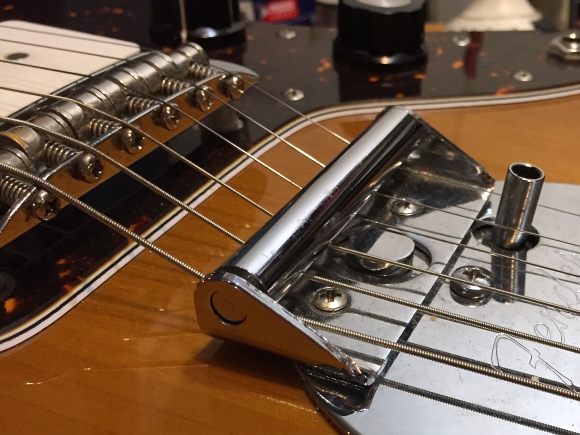



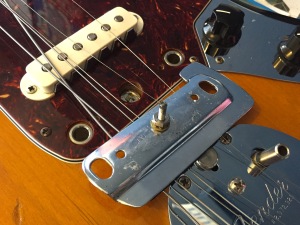 A feature shared by both the Jaguar and Bass VI – though not across all models or years of production – this curious metal plate was originally intended to be a surrogate for palm muting. Couldn’t be a simpler mechanism, really: the mute is secured to the body by two screws, and the long bolt in the middle pivots on a spring-loaded plunger sunk into the guitar body. The mute can be engaged by pressing on the plate, shifting it back and forth in place, causing the foam pad to make contact with the underside of the strings.
A feature shared by both the Jaguar and Bass VI – though not across all models or years of production – this curious metal plate was originally intended to be a surrogate for palm muting. Couldn’t be a simpler mechanism, really: the mute is secured to the body by two screws, and the long bolt in the middle pivots on a spring-loaded plunger sunk into the guitar body. The mute can be engaged by pressing on the plate, shifting it back and forth in place, causing the foam pad to make contact with the underside of the strings. It’s best to begin with the mute installed on its own––leave the bridge for later. Remember those two mounting screws I mentioned earlier? You’ll need to find the lowest possible setting for them where the mute still pivots. Try screwing them in all the way, then backing off until the foam side of the mute pops up and stays put. Then, install the bridge and make sure it doesn’t sit on top of the mute mounting screws.
It’s best to begin with the mute installed on its own––leave the bridge for later. Remember those two mounting screws I mentioned earlier? You’ll need to find the lowest possible setting for them where the mute still pivots. Try screwing them in all the way, then backing off until the foam side of the mute pops up and stays put. Then, install the bridge and make sure it doesn’t sit on top of the mute mounting screws.







 We stayed to see a demo set by Sarah Lipstate, who weaves spooky and cinematic tapestries of sound under the moniker
We stayed to see a demo set by Sarah Lipstate, who weaves spooky and cinematic tapestries of sound under the moniker 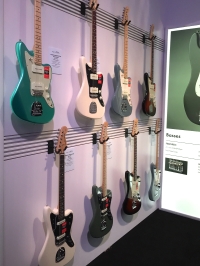 From EarthQuaker, we headed straight upstairs to check in on what Fender was up to at NAMM 2017. Fender’s exhibit is even more exciting than last year, boasting a ton of Custom Shop instruments and the new American Pro line as well. The full AMPRO line was well-represented: Strats, Teles, Jazzmasters, Jaguars, Precision and Jazz basses too. Decked out in new, bright colors, your first look at 2017 Fender is a pretty sight for sure.
From EarthQuaker, we headed straight upstairs to check in on what Fender was up to at NAMM 2017. Fender’s exhibit is even more exciting than last year, boasting a ton of Custom Shop instruments and the new American Pro line as well. The full AMPRO line was well-represented: Strats, Teles, Jazzmasters, Jaguars, Precision and Jazz basses too. Decked out in new, bright colors, your first look at 2017 Fender is a pretty sight for sure.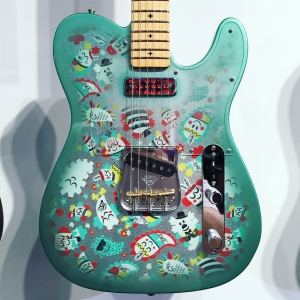


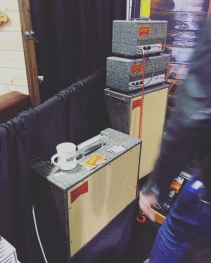 It’s always good to see friends, and
It’s always good to see friends, and 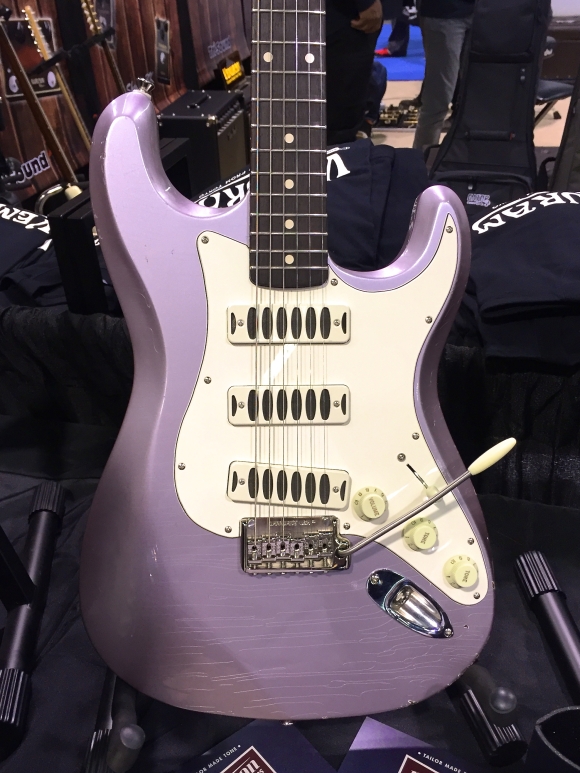
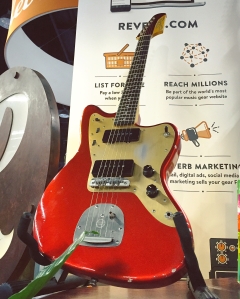 It’s always good to run into the fine folks at
It’s always good to run into the fine folks at 
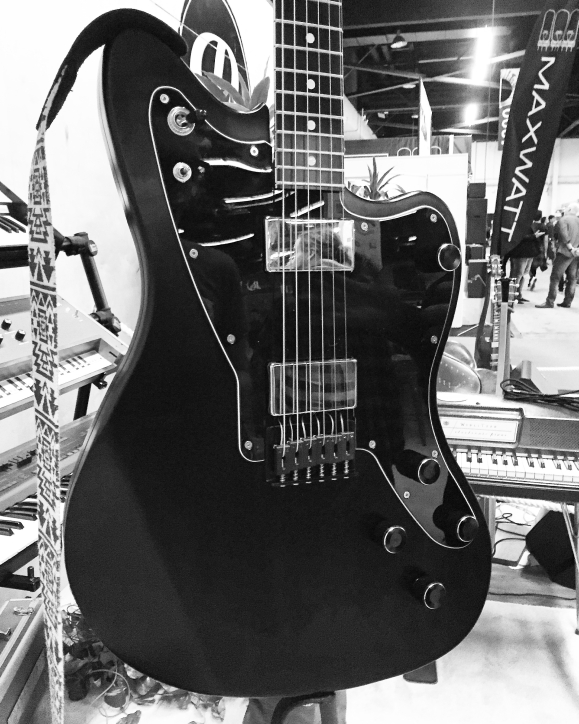
 Fender began sending them out to musicians and social media stars late in the year (where’s the love?!) but kept quiet about specs. Much of what was known about the models was deduced by blowing up blurry Instagram photos and leaked catalogue pages. Excitement soared, and soon I was buried under requests for The Jazzmaster Guy’s take on the new models.
Fender began sending them out to musicians and social media stars late in the year (where’s the love?!) but kept quiet about specs. Much of what was known about the models was deduced by blowing up blurry Instagram photos and leaked catalogue pages. Excitement soared, and soon I was buried under requests for The Jazzmaster Guy’s take on the new models.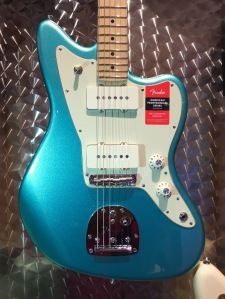
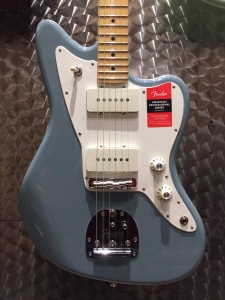
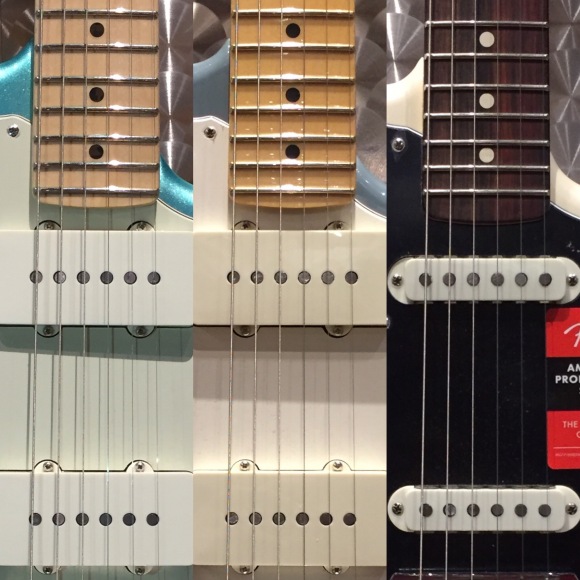

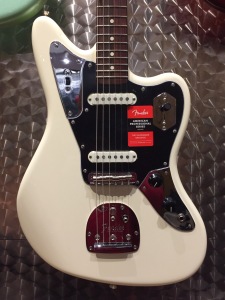
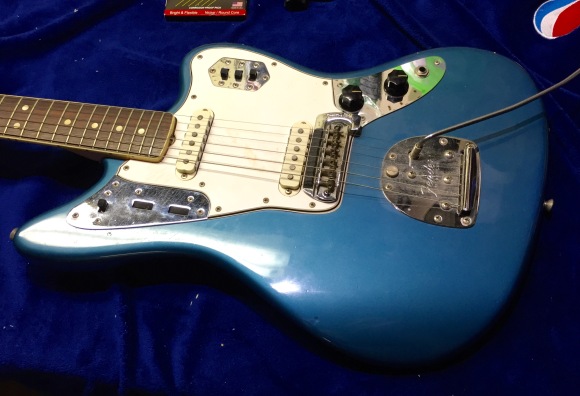
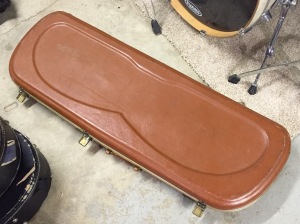
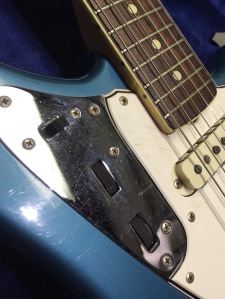 Before I arrived, Mike gave me a run-down of what the guitar might need. For starters, he wasn’t getting any sound out of the thing, and my first thought was that the Rhythm Circuit switch may have a bad solder joint. When I finally got my hands on it, the solder joints didn’t look obviously inoperable, but I thought it a safe bet to simply reflow a few key joints. This certainly helped, and suddenly I was getting sound from the Lead Circuit, with intermittent functionality of the RC.
Before I arrived, Mike gave me a run-down of what the guitar might need. For starters, he wasn’t getting any sound out of the thing, and my first thought was that the Rhythm Circuit switch may have a bad solder joint. When I finally got my hands on it, the solder joints didn’t look obviously inoperable, but I thought it a safe bet to simply reflow a few key joints. This certainly helped, and suddenly I was getting sound from the Lead Circuit, with intermittent functionality of the RC.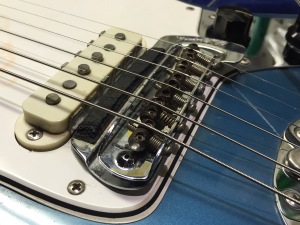 I took the strings off, removed the bridge, and gave the guitar a thorough cleaning, from finish to frets. It wasn’t filthy by any means, but the frets showed signs of disuse and the finish had a dull shine. It’s Christmas, after all; this should feel like an entirely new guitar. After a good polish of the finish and frets, and some lemon oil for the rosewood fretboard, this guitar came right back to life.
I took the strings off, removed the bridge, and gave the guitar a thorough cleaning, from finish to frets. It wasn’t filthy by any means, but the frets showed signs of disuse and the finish had a dull shine. It’s Christmas, after all; this should feel like an entirely new guitar. After a good polish of the finish and frets, and some lemon oil for the rosewood fretboard, this guitar came right back to life.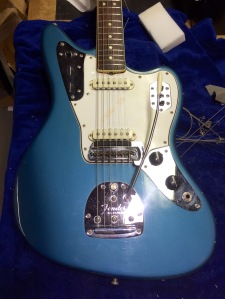 When I was finished, I hovered above the thing, not quite sure how to feel. This was the guitar from my youth that elicited such passion, though my ignorance kept me from fully embracing the model. I couldn’t believe that I was able to give back, as it were, to that first Jaguar. I dreamed about this shimmering blue guitar for years, and here I was, ready to play it as it should always have been. And play, I did; the sound, the feel, the response… it was magical.
When I was finished, I hovered above the thing, not quite sure how to feel. This was the guitar from my youth that elicited such passion, though my ignorance kept me from fully embracing the model. I couldn’t believe that I was able to give back, as it were, to that first Jaguar. I dreamed about this shimmering blue guitar for years, and here I was, ready to play it as it should always have been. And play, I did; the sound, the feel, the response… it was magical.



